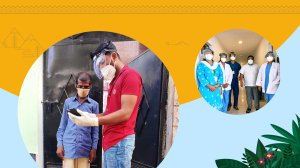As the COVID-19 pandemic evolves, business leaders everywhere face huge challenges as they seek to safely steer their organizations through the crisis. And with companies now beginning to work through how they’ll safely re-open their workplaces, they need answers to key questions. How long will the current health and economic crises last? When will we move from crisis mode and back to work in the “next normal?” What will this new reality even look like?
Working with a team of experts, leading futurist and Salesforce’s Senior Vice President of Strategic Planning, Peter Schwartz, has created a powerful scenario-planning tool to help leaders respond to these issues. By highlighting the main public health, economic, and sociopolitical dimensions of the current situation and putting them into a framework of critical uncertainties, the tool outlines three broadly applicable scenarios for the next 18–36 months.
We spoke to Schwartz to find out more.
Q. First, what is scenario planning?
It’s a way to help us explore possible futures, so we can make better decisions today. Scenario planning doesn’t work by simply predicting what’s going to happen next. Rather, it looks at the pivotal forces shaping the future — the critical uncertainties, as we call them — and tries to map where they’re taking us. Looking at the scenarios that emerge can help us make better decisions now, even in the face of uncertainties.
Salesforce is a highly future-oriented company, so a big part of my role is to think about the future for our customers. What will they want and need to build their businesses? Where are the markets going, where is regulation going? What other things will influence our environment? Scenario planning is one of the approaches we use when we look at those kinds of questions.
Q. How did you come up with the three scenarios?
My team and I started by looking at the public health, economic, and socio-political dimensions of the crisis globally. These differ hugely from place to place, of course, but nevertheless we believe that when and how any region or country reaches a next normal will generally depend on how the virus behaves there, how the economy behaves, and how people respond as a society.
More precisely, we mapped those dimensions across the three phases of the crisis that have emerged so far. For instance, nearly every country experienced an initial “losing control” phase, where the virus took everyone by surprise. Some places, such as Taiwan, responded swiftly, while others, such as North Korea and Tajikistan, took much longer to acknowledge a need for any virus suppression measures.
For most countries, that phase is now pretty much over. Nearly every country has moved into a more structured crisis response mode, aiming to control the virus’s growth through measures like lockdowns, social distancing, border closures, and contact tracing. In many places, this second “hammer” phase, to borrow a phrase from Thomas Pueyo’s influential article, has been quite successful — take New Zealand, for instance, along with Vietnam and Hong Kong. In other places, such as Yemen, there may still be a long way to go.
More recently, a third “reopening” phase has started to take shape as countries seek to safely end shutdowns, stabilize economies, and accelerate growth. In our model — again following Pueyo — we refer to this phase as “the dance,” because it will likely involve a kind of quickstep with the disease, reopening then potentially shutting down again to keep infection under control.
It’s this critical third phase that will give shape to our next normal. So to get more detail on what that new reality might look like, we worked to identify seven critical uncertainties that have emerged along with the virus. For example, how timely and effective will suppression be? Will healthcare capacity cope with the peak and beyond? How will we go back to work, within and across countries? How quickly and broadly will the economy recover?
Crucially, it’s the interplay of these uncertainties that will determine when and how a country reaches a next normal. As we analyzed that interplay, three different paths to the future emerged, each representing a crisis of a different depth and duration.
Q. The three scenarios that you came up with span the next 18–36 months. What do they each look like?
Each of the three scenarios begin from one of three outcomes we’ve already seen in the progression of the virus. The first, most optimistic scenario assumes that things go mostly right. People maintain social distancing, the virus does not come back later in the year, immunity persists, and economic policy is effective. Re-opening begins soon through mid-summer, allowing a path to the next normal to begin by spring 2021, after a vaccine arrives enabling the economy to return to growth.
In the second scenario, perhaps more realistically for the majority of countries, the virus persists, with a second wave resurgence in the winter requiring another lockdown, causing a much more severe economic recession. A vaccine is available by mid-2021, signaling reopening and steps toward the next normal.
In our third and most pessimistic scenario, the virus resurges in a giant second wave, as large as what we’ve seen in the worst hit areas to date. The lengthy lockdown that is required leads to a long and deep recession, with profound societal impact. With no vaccine becoming available, no new normal arrives. Instead, a “COVID Normal” emerges, with continuing waves of the virus, persistent economic uncertainty, and deep societal unrest.
It’s important to emphasize, however, that not only will outcomes be different in every geography in the world, but timings will vary too. So, business and government leaders will need to carefully think through how these scenarios might play out for them locally. Layering in details of local dynamics and policies in response to each of our seven critical uncertainties will help them determine how the next normal will take shape in their area.
Q. What else do companies need to be thinking about as they plan for the next normal? Are certain industries at higher risk?
We can all see that some industries are at much higher risk than others, and also that larger-scale organizations are in a better position to weather the storm and secure government aid. Even in our optimistic scenario, the recovery will be two-speed, with some lagging for a long time while others charge ahead.
I think the specific challenges will differ, depending on the industry. Take the energy sector, for example. Typically, a large oil and gas company would have a core number of employees who can work remotely with relative ease. But how do business leaders best go about implementing social distancing conditions for the hundreds of thousands of people they may have working in their refineries, or on offshore platforms?
With these sorts of challenges, the companies that move first will be able to share their findings, so others can learn from their experiences. And we do all have a unique opportunity to learn from this pandemic and intentionally design a better future.
After all, we’ve already started reinventing how we work, learn, shop, socialize, do medicine, and even govern through technologies that allow us to operate remotely. What more can we do remotely, so we don’t have to travel halfway around the world for a one-hour meeting? How can we rethink our supply chains to make them more resilient in the face of disruptions like this pandemic?
To make those sorts of changes, companies will need the enabling foundation of a digital transformation. Those that undergo that transformation and are also willing to think creatively and adapt will be in a stronger position to succeed in the next normal. The longer the crisis lasts, the more dramatic changes we should expect to see, and the benefits will flow to those who are the most willing to consider ideas that were once considered radical or even unthinkable.
Q. What are some other ways Salesforce is helping businesses to build their resilience in the next normal?
The pandemic impacts everyone, reminding us that we’re all connected and have obligations to each other. At Salesforce, we’re working tirelessly to leverage our resources, relationships and products to help all of us navigate through this time of crisis. Take Work.com, for example — that’s a set of new technology solutions and resources we’ve come up with to help businesses and community leaders around the world reopen safely, reskill employees and respond efficiently on the heels of COVID-19. Work.com includes tools to help with contact tracing, shift management, grants and volunteer management, and more.
We also have a huge range of other thought leadership materials, tips and resources to help companies manage their business during this time of immense change on our Leading Through Change resource hub. We know we don’t have all the answers, but we hope that by sharing our learnings and best practices, we can help propel society forward.
For more on how Salesforce is supporting companies in their response to COVID-19, visit our resource hub.
















